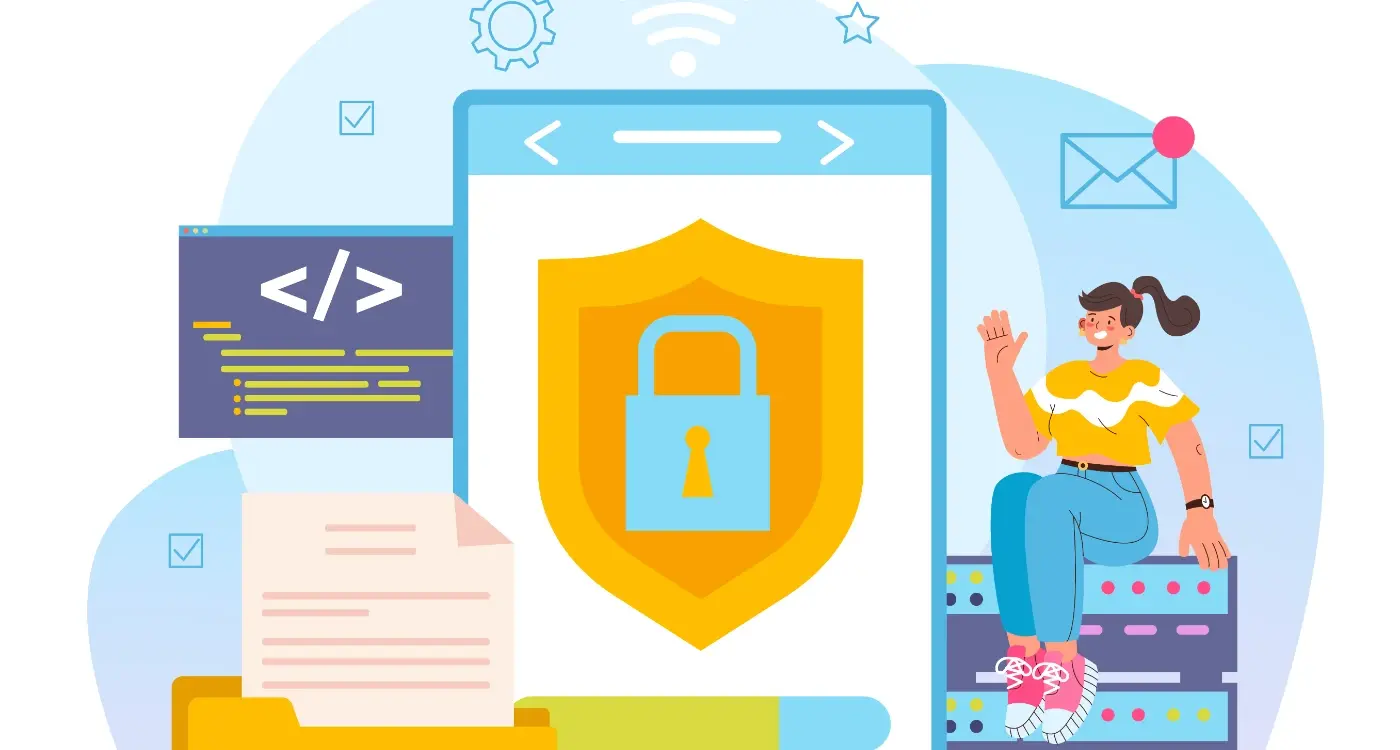How Do I Test the Security of My Mobile App?
Let's face it—mobile app security can be a bit intimidating. I've worked with dozens of companies who've built amazing apps but completely overlooked the security side of things. Not because they didn't care, but because they simply didn't know where to start. And that's exactly why we created this guide. After spending 8+ years building secure mobile applications at Glance, we've learned what works, what doesn't, and how to test your app's security without needing a PhD in cybersecurity.
Mobile apps are uniquely vulnerable to security risks. They store sensitive user data, connect to various APIs, and often run on devices that could be lost or stolen. Testing your app's security isn't just a box-ticking exercise—it's about protecting your users and your business reputation. Throughout this guide, we'll cover everything from identifying common vulnerabilities to implementing practical testing techniques that anyone can follow.
Security testing shouldn't be the last thing you think about before launch; it should be baked into every stage of your development process
Whether you're a startup founder worried about your first app or an experienced developer wanting to improve your security practices, you'll find practical advice here. We won't bore you with complex jargon or theoretical concepts that don't apply to real-world situations. Instead, we'll focus on actionable steps you can take right now to test your app's security—regardless of your technical background. So let's get started with understanding what we're actually protecting against!
Understanding Mobile App Security Risks
Let's talk about mobile app security risks—they're a bit like the creepy crawlies hiding under your bed. You might not see them, but they could be there! After spending 8+ years at Glance building mobile apps, I've seen plenty of security nightmares that could have been avoided with proper understanding. The most common issues we encounter aren't actually the complex hacks you see in films; they're basic oversights that developers make day in, day out.
Common Security Threats
Insecure data storage is a major risk—this happens when apps store sensitive information without proper encryption. Imagine keeping your house key under the doormat; anyone who knows where to look can find it! Weak authentication is another big one; too many apps still use simple passwords or don't implement two-factor authentication. Then there's the issue of unprotected APIs—these act as doorways between your app and external services, and without proper locks, they're easy entry points for attackers.
Why These Risks Matter
The consequences of ignoring these risks can be devastating. I once worked with a client who had to notify 50,000 users that their personal data had been exposed—all because of a small oversight in how the app handled login sessions. It's not just about protecting data though; it's about protecting your reputation. Users today are increasingly aware of privacy issues and won't stick around if they don't trust your app. Plus, with regulations like GDPR, security isn't just good practice—it's the law! In the next chapter, we'll look at how to set up a proper security testing framework to catch these issues before they become problems.
Setting Up a Security Testing Framework
Let me tell you—setting up a proper security testing framework isn't as complicated as it sounds. I've helped dozens of clients establish these, and the key is starting with a structured approach. Your framework needs to cover multiple security aspects while fitting into your development workflow. Think of it as creating a safety net that catches vulnerabilities before they become problems.
The first step is choosing the right tools for your specific needs. There are plenty of options out there, from open-source to commercial solutions, each with its strengths. My experience has shown that combining automated tools with manual testing gives the best results. No single tool catches everything; that's just the reality of security testing.
Essential Components of Your Testing Framework
- Tool selection: OWASP ZAP, MobSF, Burp Suite
- Test environment setup: Separate from production
- Test data preparation: Never use real user data
- Testing schedule: Integrate with your development cycle
- Reporting system: Track vulnerabilities and fixes
When setting up your framework, start small and expand gradually. Beginning with just one or two tools and a basic testing routine is far better than trying to implement everything at once and getting overwhelmed.
Integration with Development Workflow
The most successful security testing frameworks I've seen are those that integrate seamlessly with existing development processes. Automation is brilliant for this—running basic security scans alongside your regular build process means issues are caught early. Manual penetration testing can then be scheduled at key development milestones. Finding this balance makes security testing a natural part of development rather than a bothersome add-on.
Static Code Analysis for Vulnerabilities
Let's talk about static code analysis—it's like having a second pair of eyes checking your code before it ever runs. I've been using these tools for years and they're absolute lifesavers! Static analysis tools scan your source code without actually executing it, looking for potential security issues and coding mistakes that might lead to vulnerabilities.
Popular Static Analysis Tools
There are loads of tools available depending on what platform you're developing for. For iOS apps, I always recommend running through your code with tools like SwiftLint or Infer. Android developers might lean towards tools like FindBugs, SonarQube or Android Lint. These tools can spot problems ranging from simple coding standards violations to serious security flaws—things like hardcoded credentials, insecure random number generation, or SQL injection vulnerabilities that could compromise user data.
- Insecure data storage detection
- Buffer overflow identification
- Potential injection vulnerabilities
- Authentication weaknesses
- Weak cryptography implementation
Integrating Into Your Workflow
The best approach is to integrate these tools directly into your development process. Run them automatically as part of your build process—this way issues get caught early when they're cheaper and easier to fix. You don't need to fix every single warning (some tools can be quite noisy!), but do pay special attention to security-related findings. Setting up a baseline for existing code and focusing on keeping new code clean works brilliantly for older projects that might generate too many initial warnings.
Static analysis isn't perfect—it can't find every possible vulnerability and sometimes raises false alarms—but it's an essential first line of defence that catches common mistakes before they ever reach your users. Trust me, it's much better to have a tool point out your security flaws than a hacker!
Dynamic Testing and Runtime Assessments
Unlike static analysis that looks at your code without running it, dynamic testing examines your mobile app while it's actually working—think of it as watching your app in action rather than just reading its blueprint. I've seen plenty of security issues that only appear when an app is running, which is why this step can't be skipped! Dynamic testing involves installing your app on a real or virtual device and poking around to see what breaks or leaks data.
Tools for the job
For dynamic testing, you'll need some specialised tools. OWASP ZAP and Burp Suite are brilliant for intercepting network traffic—they act as a middle-man between your app and the internet, letting you see and even modify the data being sent. They're not too difficult to set up, and they can reveal surprising vulnerabilities. For iOS and Android, there are also platform-specific tools like iDB (iOS) and Drozer (Android) that help you examine how your app interacts with the device itself.
Dynamic testing caught an issue in our banking app that static analysis missed completely—a vulnerability that only appeared when the app was communicating with our servers under specific conditions.
Don't forget to check how your app behaves when unexpected things happen—what if the user loses internet connection mid-transaction? What if they receive a phone call while entering payment details? These real-world scenarios often expose security weaknesses that perfect-condition testing won't find. I typically run through a checklist of these "chaos scenarios" for every app I test; it's amazing what you can discover when you deliberately try to break things!
API Security Testing for Mobile Apps
APIs are the backbone of modern mobile apps—they connect your app to all those external services that make it useful. But they're also a massive security risk if not properly tested. I've seen countless apps leaking data through poorly secured APIs, and trust me, it's not pretty when users find out their information is exposed!
When testing API security, I always start with the basics. Is the connection encrypted with HTTPS? Are you using proper authentication? These might seem obvious, but you'd be shocked at how many developers skip these fundamental steps. Beyond that, you need to check if your API endpoints are properly validating input and authorising access—this isn't just about keeping bad actors out; it's about protecting your users' data.
Common API Security Tests
- Authentication testing — check if tokens are properly implemented and can't be easily forged
- Authorisation testing — verify users can only access what they're supposed to
- Input validation — test how your API handles unexpected or malicious inputs
- Rate limiting — ensure your API can't be overwhelmed by too many requests
- Sensitive data exposure — check that private data isn't leaked in responses
Automated tools can help with API security testing, but don't rely on them exclusively. I always recommend combining automated scanning with manual testing. The human eye can spot logical flaws that tools miss. Remember that your API security is only as strong as its weakest link—one vulnerable endpoint can compromise your entire app.
Authentication and Data Protection Testing
Let me tell you something about authentication testing that most people miss—it's not just about checking if passwords work! After spending years breaking into apps (legally, I promise), I've found that authentication is often the weakest link. You need to check for basic stuff like weak password policies, but also more complex issues like session management flaws. Can a user remain logged in forever? That's a problem. Does your app accept "Password123" as valid? Also a problem.
Data protection goes hand-in-hand with authentication. Once users are in your app, what happens to their information? Test your encryption methods—both for data at rest and in transit. Are you storing sensitive info in plain text on the device? Big no-no. I've seen banking apps accidentally cache account numbers in unprotected local storage; don't make that mistake! Test how your app handles certificates too—proper certificate pinning can prevent man-in-the-middle attacks.
Always test biometric authentication thoroughly if you're using it. Make sure it falls back gracefully to password authentication and can't be easily bypassed.
Testing Multi-factor Authentication
Multi-factor authentication adds an extra security layer, but it needs proper testing. Try to bypass it. Try to brute-force it. Try to social-engineer it. Check what happens when a user loses access to their second factor—is the recovery process secure or a massive backdoor? These tests might seem tedious, but they're absolutely worth it; they could save you from a data breach down the line.
Creating Your Mobile App Security Checklist
After nearly a decade of building mobile apps, I've learned that a proper security checklist is your best friend when it comes to preventing those middle-of-the-night panic attacks about data breaches. It's not the most exciting part of app development—but it's certainly better than explaining to clients why their users' data is now being sold on some dodgy forum!
Your security checklist shouldn't be a one-size-fits-all document. Each app has different needs and risks. For a banking app, you'll need stringent checks for encryption and authentication; for a simple recipe app, data protection might be your primary concern. The trick is making sure you've covered all your bases without getting bogged down in unnecessary tests.
Essential Security Checklist Items
- Input validation checks—are you sanitising all user inputs?
- Authentication mechanisms review—is two-factor authentication implemented?
- Data storage assessment—is sensitive information encrypted at rest?
- API security verification—are your endpoints properly secured?
- Session handling review—do sessions expire appropriately?
- Third-party library audit—have you checked for known vulnerabilities?
- OS-specific security features implementation—are you using the latest security frameworks?
I cannot stress enough how this checklist should be a living document. Update it regularly as new threats emerge and your app evolves. And don't just create it and forget about it—make it part of your regular development cycle. We often run through our checklist before each major release; it's saved us from embarrassing security issues more times than I care to admit!
Conclusion
Throughout this guide, we've covered the critical aspects of mobile app security testing—from identifying risks to implementing a comprehensive testing framework. Security isn't just a checkbox; it's an ongoing process that requires attention at every stage of your app's lifecycle. I've seen too many developers treat security as an afterthought only to face devastating consequences later!
The reality is that security threats are constantly evolving, which means your testing approach must evolve too. Start with a solid foundation: implement static code analysis, conduct dynamic testing, secure your APIs, and verify your authentication mechanisms. These steps—combined with a well-structured security checklist—will significantly reduce your app's vulnerability to attacks.
After working with hundreds of apps over the years, I can tell you that the most secure ones aren't necessarily those with the biggest budgets; they're the ones where security was baked into the development process from day one. Don't wait until your app is compromised to take security seriously—by then it's too late! Your users trust you with their data; protecting that trust should be non-negotiable. Whether you're building your first app or your fiftieth, making security testing a priority will save you headaches, money and reputation damage down the line.
Share this
Subscribe To Our Learning Centre
You May Also Like
These Related Guides

What Are the Essential Steps for Secure Enterprise Apps?

What Security Steps Does My Retail App Need to Follow?



